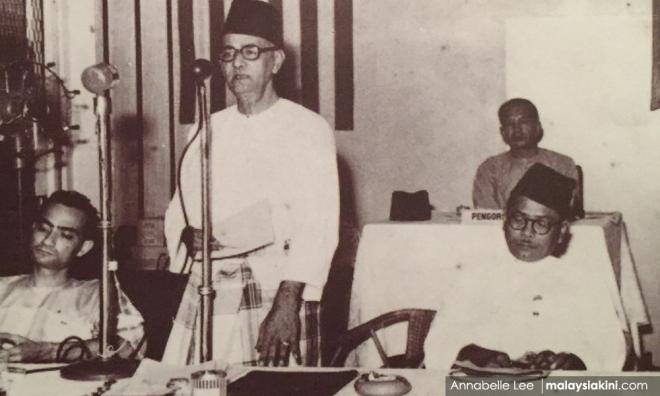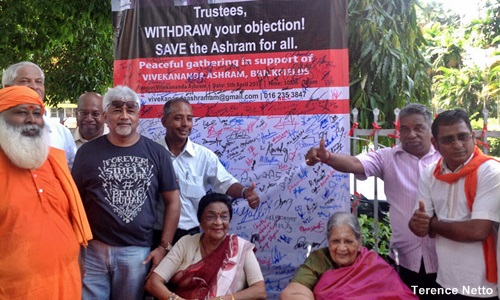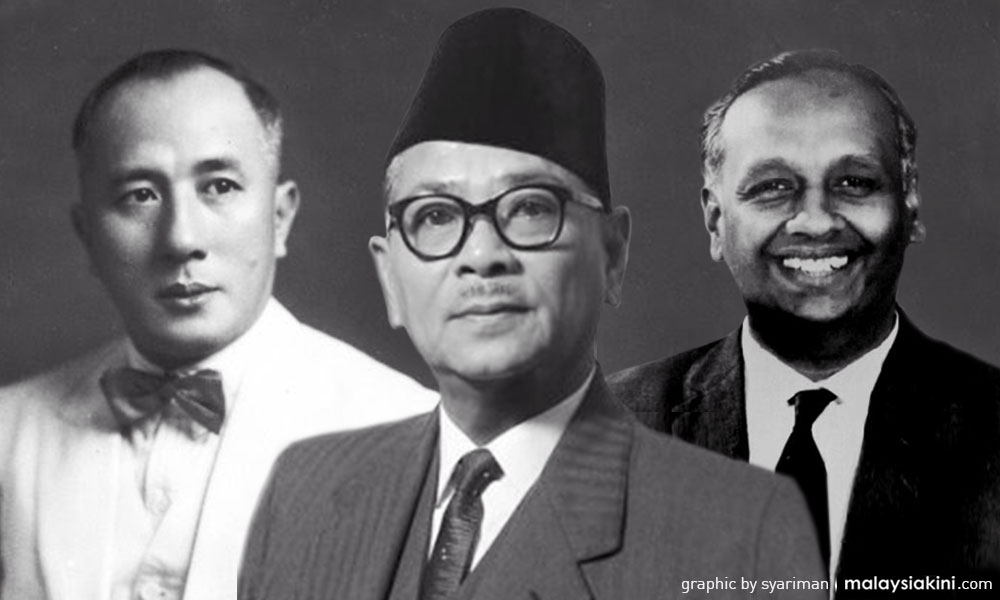

DAP's Chinese debate is larger than its party
by James Chai
by James Chai
Very few people in this country would have the privilege of being handpicked by Onn Jaafar to run as an election candidate. And no one but one woman could say that she has the privilege of being the first female elected official in the country - only Devaki Krishnan.
“Onn wanted me to contest because I was a teacher and was known in my community,” she said. Devaki was popular in Brickfields, the constituency (Bangsar) she would contest. Every election that returned her as a winner saw her given a “princess reception” where she would stand and wave on an unhooded motorcade.
But what is most interesting about Devaki (photo above, wearing pink saree) is that she was the only person to survive Onn Jaafar’s multiracial experiment.
Three years before Onn (standing, photo above) approached Devaki, he quietly harboured a dangerous idealism: a multiracial party. As president, he told Umno that “Umno’s objective is the independence of the whole country. This cannot be achieved unless there is unity with other races who are prepared to owe full allegiance to Malaya.”
He urged Umno to open up to non-Malays, as “it is absolutely necessary for the Malays to obtain closer ties with other people in this country,” and to choose friendship over enmity.
Ahead of his time
Regarded a radical by the Umno leadership, Onn proposed to change the party name to “United Malayan National Organisation”, and its slogan from “Hidup Melayu” to “Merdeka”.
Sensing that he could no longer persuade an immovable Umno, he resigned and formed the multiracial Independence of Malaya Party (IMP). When the first-ever open election (Kuala Lumpur municipal election) approached in 1952, Onn needed to find sufficient winnable non-Malay candidates, and Devaki was his crown jewel.
However, in the same election, IMP’s rival Umno was able to secure a tie-up with MCA at the eleventh hour, and when the election was over, IMP was left with only one seat: Devaki’s Bangsar seat.
The multiracial experiment has failed.
Until today, this is the best evidence to show that Malayans in the 1950s were not ready to cross racial lines, either in politics or society. Even when IMP opened its doors to non-Malays, the number of participants was not encouraging.
Non-Malays were suspicious of Onn’s intentions, and they assumed that their rights would be cast aside once independence was obtained. They were also reminded by the Malays grassroots’ opposition against IMP. Initial support was succeedingly withdrawn.
“Onn wanted me to contest because I was a teacher and was known in my community,” she said. Devaki was popular in Brickfields, the constituency (Bangsar) she would contest. Every election that returned her as a winner saw her given a “princess reception” where she would stand and wave on an unhooded motorcade.
But what is most interesting about Devaki (photo above, wearing pink saree) is that she was the only person to survive Onn Jaafar’s multiracial experiment.
Three years before Onn (standing, photo above) approached Devaki, he quietly harboured a dangerous idealism: a multiracial party. As president, he told Umno that “Umno’s objective is the independence of the whole country. This cannot be achieved unless there is unity with other races who are prepared to owe full allegiance to Malaya.”
He urged Umno to open up to non-Malays, as “it is absolutely necessary for the Malays to obtain closer ties with other people in this country,” and to choose friendship over enmity.
Ahead of his time
Regarded a radical by the Umno leadership, Onn proposed to change the party name to “United Malayan National Organisation”, and its slogan from “Hidup Melayu” to “Merdeka”.
Sensing that he could no longer persuade an immovable Umno, he resigned and formed the multiracial Independence of Malaya Party (IMP). When the first-ever open election (Kuala Lumpur municipal election) approached in 1952, Onn needed to find sufficient winnable non-Malay candidates, and Devaki was his crown jewel.
However, in the same election, IMP’s rival Umno was able to secure a tie-up with MCA at the eleventh hour, and when the election was over, IMP was left with only one seat: Devaki’s Bangsar seat.
The multiracial experiment has failed.
Until today, this is the best evidence to show that Malayans in the 1950s were not ready to cross racial lines, either in politics or society. Even when IMP opened its doors to non-Malays, the number of participants was not encouraging.
Non-Malays were suspicious of Onn’s intentions, and they assumed that their rights would be cast aside once independence was obtained. They were also reminded by the Malays grassroots’ opposition against IMP. Initial support was succeedingly withdrawn.

Tan Cheng Lock, Tunku Abdul Rahman and VT Sambanthan
Malayan voters could only count on race-based elites to protect them: Tunku Abdul Rahman from Umno, Tan Cheng Lock from MCA and VT Sambanthan from MIC. A multiracial model was infeasible that Devaki eventually flocked to MIC for more meaningful service.
The façade of unity
Underlying the consociational model of housing all three race-based parties under one roof created a facade of moderation and unity, but hides an inherent contradiction as a price to pay.
For each race-based party to succeed, they would have to pursue their racial cause in full. This meant that elements of extremist demands are no longer the exception but the rule for mostly mediocre leaders. And that extremism would hurt the other race-based parties in the coalition because race is a zero-sum game.
When Umno fails to curtail their extremism (keris-waving and insults-hurling), MCA would look like a second-fiddle without a voice. If MCA retaliates, this would hurt coalition-relationship and damage the social fabric of society; if they do not retaliate, they look weak.
The decline of MCA was inevitable as the inherent contradiction would eat up minorities first, resulting in a downward spiral destined to end in a tragedy.
As the decades pass, more Chinese recognise the limitations of MCA. Their party name became synonymous with “weak” in the Chinese community for its failure to uphold the rights and interests of the minority group.
So they flocked to the party that campaigns as MCA’s contrast: DAP. To many, issues like recognising the UEC, increasing funding for vernacular schools and protecting Chinese heritage and culture have a higher chance of success with the more competent and professional DAP.
By putting themselves as a direct contrast to the MCA, calling out its leaders for their transgressions, DAP was able to absorb the Chinese voter share close to a maximum when they reached 2018.
It is with this backdrop that we understand DAP’s recent generational debate of multiracialism versus the Chinese-first multiracial party. This is not a simple debate between race-based or multiracialism approaches - it is more nuanced than that.
The debate about the Chinese
Fundamentally, it is a question of the Chinese negotiating their place under the Malaysian sun. It is not the same debate as in 1957, when many Chinese still maintained ties to China, have not interacted with other races, speak little or no Malay, and the meaning of nationhood was hardly conceptualised beyond economics and capital.
As a race, do the Chinese continue their old method of sticking closely among themselves as a way of preserving their culture or do the Chinese work intimately with other races as a way of merging and distributing their culture? Both are valid methods of survival for a race dwindling in numbers.
The façade of unity
Underlying the consociational model of housing all three race-based parties under one roof created a facade of moderation and unity, but hides an inherent contradiction as a price to pay.
For each race-based party to succeed, they would have to pursue their racial cause in full. This meant that elements of extremist demands are no longer the exception but the rule for mostly mediocre leaders. And that extremism would hurt the other race-based parties in the coalition because race is a zero-sum game.
When Umno fails to curtail their extremism (keris-waving and insults-hurling), MCA would look like a second-fiddle without a voice. If MCA retaliates, this would hurt coalition-relationship and damage the social fabric of society; if they do not retaliate, they look weak.
The decline of MCA was inevitable as the inherent contradiction would eat up minorities first, resulting in a downward spiral destined to end in a tragedy.
As the decades pass, more Chinese recognise the limitations of MCA. Their party name became synonymous with “weak” in the Chinese community for its failure to uphold the rights and interests of the minority group.
So they flocked to the party that campaigns as MCA’s contrast: DAP. To many, issues like recognising the UEC, increasing funding for vernacular schools and protecting Chinese heritage and culture have a higher chance of success with the more competent and professional DAP.
By putting themselves as a direct contrast to the MCA, calling out its leaders for their transgressions, DAP was able to absorb the Chinese voter share close to a maximum when they reached 2018.
It is with this backdrop that we understand DAP’s recent generational debate of multiracialism versus the Chinese-first multiracial party. This is not a simple debate between race-based or multiracialism approaches - it is more nuanced than that.
The debate about the Chinese
Fundamentally, it is a question of the Chinese negotiating their place under the Malaysian sun. It is not the same debate as in 1957, when many Chinese still maintained ties to China, have not interacted with other races, speak little or no Malay, and the meaning of nationhood was hardly conceptualised beyond economics and capital.
As a race, do the Chinese continue their old method of sticking closely among themselves as a way of preserving their culture or do the Chinese work intimately with other races as a way of merging and distributing their culture? Both are valid methods of survival for a race dwindling in numbers.

Thus, the debate between Ronnie Liu (representing the old method) and Tony Pua and Hannah Yeoh (representing the new method) is not confined to an internal party tussle. It represents a vision to locate the Chinese in a multiracial future we cannot resist.
Unlike other party infighting, this one is worth having publicly.
In her colourful home in Brickfields, Devaki is now 98 years old. She still speaks fondly of her days in politics; the gentlemanly Onn Jaafar, the gem of a man, eggplant-curry-loving Tunku, and how she surpassed Samy Vellu as MIC’s longest-serving member.
Did she regret the too-fast-too-soon multiracial experiment with Onn? Did she compromise her values by receding to MIC? Did she think Malaysia is now ready to depart from communal politics to a fully multiracial one?
When the Jalur Gemilang at her porch waves by the wind, she could not hide her smile. “It’s very pleasant to the eyes and peaceful to the heart. It settles the mind.”
JAMES CHAI is a legal consultant and researcher working for Invoke, among others. He also blogs at jameschai.com.my. You may reach him at jameschai.mpuk@gmail.com
Unlike other party infighting, this one is worth having publicly.
In her colourful home in Brickfields, Devaki is now 98 years old. She still speaks fondly of her days in politics; the gentlemanly Onn Jaafar, the gem of a man, eggplant-curry-loving Tunku, and how she surpassed Samy Vellu as MIC’s longest-serving member.
Did she regret the too-fast-too-soon multiracial experiment with Onn? Did she compromise her values by receding to MIC? Did she think Malaysia is now ready to depart from communal politics to a fully multiracial one?
When the Jalur Gemilang at her porch waves by the wind, she could not hide her smile. “It’s very pleasant to the eyes and peaceful to the heart. It settles the mind.”
JAMES CHAI is a legal consultant and researcher working for Invoke, among others. He also blogs at jameschai.com.my. You may reach him at jameschai.mpuk@gmail.com
What is "Chinese-ness" ?
ReplyDeleteI grew up in a Malay Kampung, mostly Malay neighbours. I spoke Malay almost as early as I learnt to speak Chinese dialect.
I don't read Chinese, largely the outcome in my childhood I lived practically too far away to attend any Chinese school.
Very much due to my childhood experiences, I can mix comfortably with any and all races , Brown, Black, White.
I have no time for Chinese Race Supremacists ( yes - they exist ).
Wakakakakakaka…
DeleteThere r supremacists in every conceivable races on earth.
The questions r the numeric & indirectly how this number is been propagated within the race!
Maybe u r a closet supremacist w/o knowing bcoz u identified yrself with the supremacy fart surrounding u.
Guess, u WON'T be able to distinguish which is which.
Ini pasal orang India dijemput masuk UMNO 60 tahun dulu pun boleh kait dengan DAP hari ini...? Apadah James Chai...tak ada cerita lain ke...?
ReplyDeletedap idolize englishness, they want nothing from malayness n chineseness n indianness except our vote.
ReplyDelete